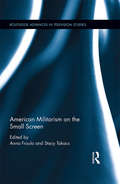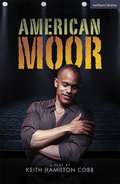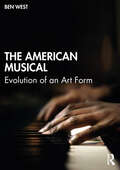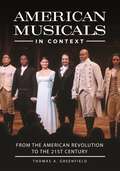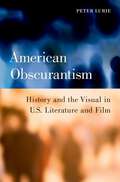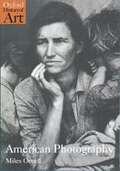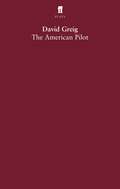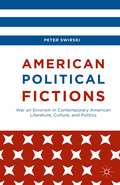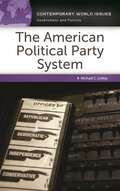- Table View
- List View
American Militarism on the Small Screen (Routledge Advances in Television Studies)
by Anna Froula Stacy TakacsAnna Froula is Associate Professor of Film Studies in the Department of English at East Carolina University, USA Stacy Takacs is Associate Professor and Director of American Studies at Oklahoma State University, USA
American Militarism on the Small Screen (Routledge Advances in Television Studies)
by Anna Froula Stacy TakacsAnna Froula is Associate Professor of Film Studies in the Department of English at East Carolina University, USA Stacy Takacs is Associate Professor and Director of American Studies at Oklahoma State University, USA
American Milliners and their World: Women's Work from Revolution to Rock and Roll
by Nadine StewartStudies of millinery tend to focus on hats, rather than the extraordinarily skilled workers who create them. American Milliners and their World sets out to redress the balance, examining the position of the milliner in American society from the 18th to the 20th century. Concentrating on the struggle of female hat-makers to claim their social place, it investigates how they were influenced by changing attitudes towards women in the workplace.Drawing on diaries, etiquette books, trade journals and contemporary literature, Stewart illustrates how making hats became big business, but milliners' working conditions failed to improve. Taking the reader from the Industrial Revolution of the 1760s to the sexual revolution of the 1960s, and from Belle Epoque feathers to elegant cloches and Jackie Kennedy's pillbox hat, the book offers a new insight into the rise and fall of a fashionable industry.Beautifully illustrated and packed with original research, American Milliners and their World blends fashion history and anthropology to tell the forgotten stories of the women behind some of the most iconic hats of the last three centuries.
American Milliners and their World: Women's Work from Revolution to Rock and Roll
by Nadine StewartStudies of millinery tend to focus on hats, rather than the extraordinarily skilled workers who create them. American Milliners and their World sets out to redress the balance, examining the position of the milliner in American society from the 18th to the 20th century. Concentrating on the struggle of female hat-makers to claim their social place, it investigates how they were influenced by changing attitudes towards women in the workplace.Drawing on diaries, etiquette books, trade journals and contemporary literature, Stewart illustrates how making hats became big business, but milliners' working conditions failed to improve. Taking the reader from the Industrial Revolution of the 1760s to the sexual revolution of the 1960s, and from Belle Epoque feathers to elegant cloches and Jackie Kennedy's pillbox hat, the book offers a new insight into the rise and fall of a fashionable industry.Beautifully illustrated and packed with original research, American Milliners and their World blends fashion history and anthropology to tell the forgotten stories of the women behind some of the most iconic hats of the last three centuries.
American Moor (PDF)
by Keith CobbSpeak of me as I am; nothing extenuate,Nor set down aught in malice...The intelligent, intuitive, indomitable, large, black, American male actor explores Shakespeare's Othello, race, and America… not necessarily in that order.American Moor is a play that examines the experience and perspective of black men in America through the metaphor of William Shakespeare's character, Othello. It is a play about race in America, but it is also a play about who gets to make art, who gets to play Shakespeare, about the qualitative decline of the American theatre, about actors and acting, and about the nature of unadulterated love. It is an often funny, often heartbreaking examination of the pall of privileged perspective that is ultimately so injurious to us all.Originally written in 2012, American Moor has been seen across America, including a successful run off-Broadway in 2019.
American Moor (Modern Plays)
by Keith Hamilton CobbSpeak of me as I am; nothing extenuate,Nor set down aught in malice...The intelligent, intuitive, indomitable, large, black, American male actor explores Shakespeare's Othello, race, and America… not necessarily in that order.American Moor is a play that examines the experience and perspective of black men in America through the metaphor of William Shakespeare's character, Othello. It is a play about race in America, but it is also a play about who gets to make art, who gets to play Shakespeare, about the qualitative decline of the American theatre, about actors and acting, and about the nature of unadulterated love. It is an often funny, often heartbreaking examination of the pall of privileged perspective that is ultimately so injurious to us all.Originally written in 2012, American Moor has been seen across America, including a successful run off-Broadway in 2019.
The American Musical: Evolution of an Art Form
by Ben WestThe American Musical is a comprehensive history of an American art form. It delivers a detailed and definitive portrait of the American musical’s artistic evolution over the course of seven distinct, newly defined eras, with a unique perspective gleaned from research at more than twenty different archives across the United States.Individual in both its approach and coverage, The American Musical traces the form’s creative journey from its 19th century beginnings, through its 20th century maturation, and to the turn of the 21st century, shedding new light on a myriad of authors, directors, and craftspeople who worked on Broadway and beyond. This book actively addresses the form’s often overlooked female and African-American artists, provides an in-depth accounting of such outside influences as minstrelsy, vaudeville, nightclubs, and burlesque, and explores the dynamic relationship between the form and the consciousness of its country.The American Musical is a fascinating and insightful read for students, artists, and afficionados of the American musical, and anyone with an interest in this singular form of entertainment.
The American Musical: Evolution of an Art Form
by Ben WestThe American Musical is a comprehensive history of an American art form. It delivers a detailed and definitive portrait of the American musical’s artistic evolution over the course of seven distinct, newly defined eras, with a unique perspective gleaned from research at more than twenty different archives across the United States.Individual in both its approach and coverage, The American Musical traces the form’s creative journey from its 19th century beginnings, through its 20th century maturation, and to the turn of the 21st century, shedding new light on a myriad of authors, directors, and craftspeople who worked on Broadway and beyond. This book actively addresses the form’s often overlooked female and African-American artists, provides an in-depth accounting of such outside influences as minstrelsy, vaudeville, nightclubs, and burlesque, and explores the dynamic relationship between the form and the consciousness of its country.The American Musical is a fascinating and insightful read for students, artists, and afficionados of the American musical, and anyone with an interest in this singular form of entertainment.
American Musical Theatre
by Steven PorterFirst Published in 1987. Split into four parts, this book seeks to inform the reader, teachers, directors and students about American Musical Theatre. Part I is a brief history of the American Musical Theatre, for it is only in the context of history that the material on which you work can be fully judged and mastered. Part II is a brief discussion of the elements of production. Knowing what ought to take place in a well-planned show can go a long way toward counteracting what does not take place in a poorly planned one. Part III is a brief discussion of how to evaluate the elements of craftmanship one expects to find in the writing and performing of a musical. The knowledge here is indispensable to the performer. It is the feel of the plane to the pilot, the touch of the key to the pianist. It is, in fact, the very life blood of the art form. Finally, Part IV provides an opportunity to put into practice what previous study has taught.
American Musical Theatre
by Steven PorterFirst Published in 1987. Split into four parts, this book seeks to inform the reader, teachers, directors and students about American Musical Theatre. Part I is a brief history of the American Musical Theatre, for it is only in the context of history that the material on which you work can be fully judged and mastered. Part II is a brief discussion of the elements of production. Knowing what ought to take place in a well-planned show can go a long way toward counteracting what does not take place in a poorly planned one. Part III is a brief discussion of how to evaluate the elements of craftmanship one expects to find in the writing and performing of a musical. The knowledge here is indispensable to the performer. It is the feel of the plane to the pilot, the touch of the key to the pianist. It is, in fact, the very life blood of the art form. Finally, Part IV provides an opportunity to put into practice what previous study has taught.
American Musicals in Context: From the American Revolution to the 21st Century
by Thomas A. GreenfieldAmerican Musicals in Context: From the American Revolution to the 21st Century gives students a fresh look at history-based musicals, helping readers to understand the American story through one of the country's most celebrated art forms: the musical.With the hit musical Hamilton (2015) captivating audiences and reshaping the way early U.S. history is taught and written about, this book offers insight into an array of musicals that explore U.S. history. The work provides a synopsis, overview of critical and audience reception, and historical context and analysis for each of 20 musicals selected for the unique and illuminating way they present the American story on the stage.Specifically, this volume explores musicals that have centered their themes, characters, and plots on some aspect of America's complex and ever-changing history. Each in its own way helps us rediscover pivotal national crises, key political decisions, defining moral choices, unspeakable and unresolved injustices, important and untold stories, defeats suffered, victories won in the face of monumental adversity, and the sacrifices borne publicly and privately in the process of creating the American narrative, one story at a time. Students will come away from the volume armed with the critical thinking skills necessary to discern fact from fiction in U.S. history.
American Musicals in Context: From the American Revolution to the 21st Century
by Thomas A. GreenfieldAmerican Musicals in Context: From the American Revolution to the 21st Century gives students a fresh look at history-based musicals, helping readers to understand the American story through one of the country's most celebrated art forms: the musical.With the hit musical Hamilton (2015) captivating audiences and reshaping the way early U.S. history is taught and written about, this book offers insight into an array of musicals that explore U.S. history. The work provides a synopsis, overview of critical and audience reception, and historical context and analysis for each of 20 musicals selected for the unique and illuminating way they present the American story on the stage.Specifically, this volume explores musicals that have centered their themes, characters, and plots on some aspect of America's complex and ever-changing history. Each in its own way helps us rediscover pivotal national crises, key political decisions, defining moral choices, unspeakable and unresolved injustices, important and untold stories, defeats suffered, victories won in the face of monumental adversity, and the sacrifices borne publicly and privately in the process of creating the American narrative, one story at a time. Students will come away from the volume armed with the critical thinking skills necessary to discern fact from fiction in U.S. history.
American Noir: The Pocket Essential Guide to American Crime Fiction, Film & TV (Pocket Essentials)
by Barry ForshawBarry Forshaw is acknowledged as a leading expert on crime fiction and films from Britain and the European countries, but a further area of expertise is American crime fiction, film and TV, as demonstrated in such books as The Rough Guide to Crime Fiction and Detective. After the success of earlier entries in his Noir series - Nordic Noir, Brit Noir and Euro Noir - he now tackles the largest and, some might argue, most impressive body of crime fiction from a single country, the United States, to produce the perfect reader's guide to modern American crime fiction. The word 'Noir' is used in its loosest sense: every major living American writer is considered (including the giants Harlan Coben, Patricia Cornwell, James Lee Burke, James Ellroy and Sara Paretsky, as well as non-crime writers such as Stephen King who stray into the genre), often through a concentration on one or two key books.Many exciting new talents are highlighted, and Barry Forshaw's knowledge of - and personal acquaintance with - many of the writers grants valuable insights into this massively popular field. But the crime genre is as much about films and TV as it is about books, and American Noir is a celebration of the former as well as the latter. US television crime drama in particular is enjoying a new golden age, and all of the important current series are covered here, as well as key important recent films.'The book canters through American Crime fiction of the early 21st century, conveys information in an easily accessible manner and provides a readable overview of the whole area, one that can be dipped into at random, consulted for specific information or read for general interest' - Mystery People'Forshaw's deep knowledge of Noir ensures this is a fascinating guide, as well as a top-notch reading list' - Crime Scene MagazineLook out for the other books in Barry Forshaw's Noir series Euro Noir, Nordic Noir, Brit Noir and Historical Noir, and for his latest book, Crime Fiction: A Reader's Guide.
American Obscurantism: History and the Visual in U.S. Literature and Film
by Peter LurieAmerican Obscurantism argues for a salutary indirection in U.S. culture. From its earliest canonical literary works through late twentieth and early twenty-first century film, the most compelling manifestations of America's troubled history have articulated this content through a unique formal and tonal obscurity. Envisioning the formidable darkness attending racial history at nearly every stage of the republic's founding and ongoing development, writers such as William Faulkner and Hart Crane or directors like the Coen brothers and Stanley Kubrick present a powerful critique of American conquest, southern plantation culture, and western frontier ideology. The book traces this arc from one of visual history's notoriously troubled texts: D.W. Griffith's The Birth of a Nation (1915). American Obscurantism engages the basis of these explorations in Poe and Melville, each of whom present notable occlusions in characters' racial understanding, an obtuseness or naïveté that is expressed by a corresponding formal opacity. Such oblique historicity as the book describes allows a method at odds with - and implicitly critical of - the historicizing trend that marked literary studies in the wake of the theoretical turn. Citing critiques such as those of Tim Dean and others of efforts to politicize literary and cultural studies, this book restores an emphasis on aesthetic and medium-specific features to argue for a formalist historicity. Working through challenges to an implicitly white-,bourgeois, heteronormative polity, American Obscurantism posits an insistent, vital racial otherness at the heart of American literature and cinema. It examines this pattern across a canon that shows more self-doubt than assuredness, arguing for the value of openness and questioning in place of epistemological or critical certainty. Following the insistence on a lamenting historical look back in the cases of Faulkner, Kubrick, and the Coens, the book ends by linking Crane's famous optimism in The Bridge, one rooted in an ecstatic celebrating of the body and an optimism attending "America" as both concept and nation-state, to the contemporary digital turn and the hope for a more inclusive visual culture as well as racial vision.
American Obscurantism: History and the Visual in U.S. Literature and Film
by Peter LurieAmerican Obscurantism argues for a salutary indirection in U.S. culture. From its earliest canonical literary works through late twentieth and early twenty-first century film, the most compelling manifestations of America's troubled history have articulated this content through a unique formal and tonal obscurity. Envisioning the formidable darkness attending racial history at nearly every stage of the republic's founding and ongoing development, writers such as William Faulkner and Hart Crane or directors like the Coen brothers and Stanley Kubrick present a powerful critique of American conquest, southern plantation culture, and western frontier ideology. The book traces this arc from one of visual history's notoriously troubled texts: D.W. Griffith's The Birth of a Nation (1915). American Obscurantism engages the basis of these explorations in Poe and Melville, each of whom present notable occlusions in characters' racial understanding, an obtuseness or naïveté that is expressed by a corresponding formal opacity. Such oblique historicity as the book describes allows a method at odds with - and implicitly critical of - the historicizing trend that marked literary studies in the wake of the theoretical turn. Citing critiques such as those of Tim Dean and others of efforts to politicize literary and cultural studies, this book restores an emphasis on aesthetic and medium-specific features to argue for a formalist historicity. Working through challenges to an implicitly white-,bourgeois, heteronormative polity, American Obscurantism posits an insistent, vital racial otherness at the heart of American literature and cinema. It examines this pattern across a canon that shows more self-doubt than assuredness, arguing for the value of openness and questioning in place of epistemological or critical certainty. Following the insistence on a lamenting historical look back in the cases of Faulkner, Kubrick, and the Coens, the book ends by linking Crane's famous optimism in The Bridge, one rooted in an ecstatic celebrating of the body and an optimism attending "America" as both concept and nation-state, to the contemporary digital turn and the hope for a more inclusive visual culture as well as racial vision.
An American Odyssey: The Life and Work of Romare Bearden
by Mary Schmidt CampbellBy the time of his death in 1988, Romare Bearden was most widely celebrated for his large-scale public murals and collages, which were reproduced in such places as Time and Esquire to symbolize and evoke the black experience in America. As Mary Schmidt Campbell shows us in this definitive, defining, and immersive biography, the relationship between art and race was central to his life and work -- a constant, driving creative tension. Bearden started as a cartoonist during his college years, but in the later 1930s turned to painting and became part of a community of artists supported by the WPA. As his reputation grew he perfected his skills, studying the European masters and analyzing and breaking down their techniques, finding new ways of applying them to the America he knew, one in which the struggle for civil rights became all-absorbing. By the time of the March on Washington in 1963, he had begun to experiment with the Projections, as he called his major collages, in which he tried to capture the full spectrum of the black experience, from the grind of daily life to broader visions and aspirations. Campbell's book offers a full and vibrant account of Bearden's life -- his years in Harlem (his studio was above the Apollo theater), to his travels and commissions, along with illuminating analysis of his work and artistic career. Campbell, who met Bearden in the 1970s, was among the first to compile a catalogue of his works. An American Odyssey goes far beyond that, offering a living portrait of an artist and the impact he made upon the world he sought both to recreate and celebrate.
An American Odyssey: The Life and Work of Romare Bearden
by Mary Schmidt CampbellBy the time of his death in 1988, Romare Bearden was most widely celebrated for his large-scale public murals and collages, which were reproduced in such places as Time and Esquire to symbolize and evoke the black experience in America. As Mary Schmidt Campbell shows us in this definitive, defining, and immersive biography, the relationship between art and race was central to his life and work -- a constant, driving creative tension. Bearden started as a cartoonist during his college years, but in the later 1930s turned to painting and became part of a community of artists supported by the WPA. As his reputation grew he perfected his skills, studying the European masters and analyzing and breaking down their techniques, finding new ways of applying them to the America he knew, one in which the struggle for civil rights became all-absorbing. By the time of the March on Washington in 1963, he had begun to experiment with the Projections, as he called his major collages, in which he tried to capture the full spectrum of the black experience, from the grind of daily life to broader visions and aspirations. Campbell's book offers a full and vibrant account of Bearden's life -- his years in Harlem (his studio was above the Apollo theater), to his travels and commissions, along with illuminating analysis of his work and artistic career. Campbell, who met Bearden in the 1970s, was among the first to compile a catalogue of his works. An American Odyssey goes far beyond that, offering a living portrait of an artist and the impact he made upon the world he sought both to recreate and celebrate.
American Painting of the Nineteenth Century: Realism, Idealism, and the American Experience
by Barbara NovakIn this distinguished work, which Hilton Kramer in The New York Times Book Review called "surely the best book ever written on the subject," Barbara Novak illuminates what is essentially American about American art. She highlights not only those aspects that appear indigenously in our art works, but also those features that consistently reappear over time. Novak examines the paintings of Washington Allston, Thomas Cole, Asher B. Durand, Fitz H. Lane, William Sidney Mount, Winslow Homer, Thomas Eakins, and Albert Pinkham Ryder. She draws provocative and original conclusions about the role in American art of spiritualism and mathematics, conceptualism and the object, and Transcendentalism and the fact. She analyzes not only the paintings but nineteenth-century aesthetics as well, achieving a unique synthesis of art and literature. Now available with a new preface and an updated bibliography, this lavishly illustrated volume--featuring more than one hundred black-and-white illustrations and sixteen full-color plates--remains one of the seminal works in American art history.
American Photography: (pdf) (Oxford History Of Art Ser.)
by Miles Orvell150 years of American photography come alive in this exciting new book, placing it in its cultural context for the first time. Orvell examines this fascinating subject through a wide range of well known and less-well known images. He ranges from portraiture and landscape photography, family albums and memory, and analyses the particularly 'American' way in which American photographers have viewed the world around them. Orvell combines a clear overview of the changing nature of photographic thinking and practice in this period with an exploration of key concepts. The result is the first coherent history of American photography, which examines issues such as the nature of photographic exploitation, experimental techniques, the power of the photograph to shock, and whether we should subscribe to the notion of a visual history. ""What a terrific book!...Rich references to literature, history, art, and popular culture make this story come alive.""--Mary Panzer, Author of Matthew Brady and the Image of History, and former curator of photographs for the Smithsonian Institution's National Portrait Gallery
American Pickers Guide to Picking
by Libby CallawayA true adventure story and the go-to guide for "picking" American treasures from anyone's backyard, straight from the stars of History's American PickersIn these pages, professional treasure hunters Mike Wolfe and Frank Fritz chronicle their road trips across the American countryside in search of "rusty gold" to buy and sell among the picking world's one-of-a-kind characters. Whether you are a fan of the show or just like finding hidden riches, you will love seeing what Wolfe and Fritz dig up and enjoy meeting the devoted collectors, extreme stockpilers, and elite dealers who they encounter along the way.Wolfe and Fritz do not deal in fine antiques. Their secondhand treasures are of the down-and-dirty and sometimes even bizarre variety, from old bicycles and vintage tools, to sun-bleached cars and handmade furniture, retired carnival games and unusual taxidermy. Assisted by Danielle Colby, who helps out at Antique Archaeology, Wolfe and Fritz buy on the cheap and then sell to dealers, art directors, interior designers, or anyone looking for a little bit of authentic Americana. The three now share their secrets to finding hidden gems, offering helpful hints that will show what average Americans can do to find the treasures that await them.From American Pickers Guide to Picking:Junk is BeautifulWhen we knock on a door, 90 percent of the time the things we find are junk. But we don't care about the odds; a picker never turns down an opportunity, no matter where it is. We've picked pickup trucks. We've picked flat beds. We've picked dumpsters. We even picked a Mercury Sable. We're looking for the unusual, the impossible, the funky, the different, the bizarre-things we have never seen before. And we'll go anywhere we have to go to find it.No location is off-limits to a hard-core picker. And there's plenty of things to be found at antique stores, thrift and consignment shops, flea markets, estate sales, and swap meets, and a lot of the tips in this book apply to finding treasures at these joints. But that's not really the kind of picking we do anymore. We look outside the box to find our junk-a word we use almost like a term of endearment: to us: junk is beautiful.
American Pickers Guide to Picking
by Libby CallawayA true adventure story and the go-to guide for "picking" American treasures from anyone's backyard, straight from the stars of History's American Pickers In these pages, professional treasure hunters Mike Wolfe and Frank Fritz chronicle their road trips across the American countryside in search of "rusty gold" to buy and sell among the picking world's one-of-a-kind characters. Whether you are a fan of the show or just like finding hidden riches, you will love seeing what Wolfe and Fritz dig up and enjoy meeting the devoted collectors, extreme stockpilers, and elite dealers who they encounter along the way. Wolfe and Fritz do not deal in fine antiques. Their secondhand treasures are of the down-and-dirty and sometimes even bizarre variety, from old bicycles and vintage tools, to sun-bleached cars and handmade furniture, retired carnival games and unusual taxidermy. Assisted by Danielle Colby, who helps out at Antique Archaeology, Wolfe and Fritz buy on the cheap and then sell to dealers, art directors, interior designers, or anyone looking for a little bit of authentic Americana. The three now share their secrets to finding hidden gems, offering helpful hints that will show what average Americans can do to find the treasures that await them.From American Pickers Guide to Picking:Junk is Beautiful When we knock on a door, 90 percent of the time the things we find are junk. But we don't care about the odds; a picker never turns down an opportunity, no matter where it is. We've picked pickup trucks. We've picked flat beds. We've picked dumpsters. We even picked a Mercury Sable. We're looking for the unusual, the impossible, the funky, the different, the bizarre-things we have never seen before. And we'll go anywhere we have to go to find it. No location is off-limits to a hard-core picker. And there's plenty of things to be found at antique stores, thrift and consignment shops, flea markets, estate sales, and swap meets, and a lot of the tips in this book apply to finding treasures at these joints. But that's not really the kind of picking we do anymore. We look outside the box to find our junk-a word we use almost like a term of endearment: to us: junk is beautiful.
The American Pilot: Outlying Island - San Diego - The American Pilot - Pyrenees - Kyoto - Being Norwegian
by David GreigA spy plane crash-lands in a remote valley in a distant country. The local villagers take in the wounded pilot and argue his fate. The American Pilot explores the way the world sees America and the way America sees the world.The American Pilot premiered with the RSC at The Other Place, Stratford-upon-Avon in April 2005.'Greig at his best.' Evening Standard.'One of the most intellectually stimulating dramatists around... A richly provocative new play.' Guardian'The sheer brilliance of Greig, storyteller and seer.' Herald.The American Pilot premiered with the RSC at The Other Place, Stratford Upon Avon, in April 2005.
American Playwriting and the Anti-Political Prejudice: Twentieth- and Twenty-First-Century Perspectives (Palgrave Studies in Theatre and Performance History)
by N. PressleyTwenty years after Tony Kushner's influential Angels in America seemed to declare a revitalized potency for the popular political play, there is a "No Politics" prejudice undermining US production and writing. This book explores the largely unrecognized cultural patterns that discourage political playwriting on the contemporary American stage.
American Political Fictions: War on Errorism in Contemporary American Literature, Culture, and Politics
by Peter SwirskiThrough a discussion of diverse art and media such as apocalyptic thrillers, rap, and television, Swirski debunks the American political system, sieving out fact from a sea of bipartisan untruths. Engaging with close analysis and multiple case studies, this book forges a more accurate picture of contemporary American culture and of America itself.
The American Political Party System: A Reference Handbook (Contemporary World Issues)
by Michael C. LeMayWhat historical factors transformed American politics into the institution we know today? This in-depth look at America's party system traces its efficacy, sustainability, and popularity through six influential presidencies spanning 1790 to the present day.Did President Obama's election serve as the impetus to the development of a seventh political party system? This compelling text sheds light on the American political process as seen through the lens of six pivotal presidencies that shaped America's culture, politics, and society and considers how our current president may be the latest transformative leader in this lineage. Covering two centuries of politics, the work offers insight into the American political machine and reveals how and why the two-party system became so dominant in American politics. Topics include the media's focus on the horse-race aspect of elections, the declining importance of party identification, and the impact of the geographical split that results in swing-states and gerrymandered districts.The work begins by dividing 200 years of politics into 6 periods influenced by a transformative president and discussing the profile of the party system in each era. The next section presents essays contributed by activists across a myriad of political parties and profiles leading political actors and organizations. The final section includes tables, primary source documents, reference lists, a detailed glossary, and a timeline of the development of American political parties that help elucidate the text and show the role political parties have played throughout history.
